Abstract
The dynamics of soil moisture and its temperature is an important criterion for evaluating soil tillage technology in terms of achieving plant production stability. Understanding changes in soil moisture and temperature depending on rainfall and air temperature is necessary to develop application models for agriculture 4.0. A hypothesis was adopted assuming that the dynamics of soil moisture and its thermal properties will depend on the technology of cultivation. Hence, the aim of the research was to learn the dynamics of soil moisture and temperature during a growing season using strip and conventional tillage. Soil moisture was monitored using TDR probes in the row and inter-row of winter barley using plowing and strip-till techniques. Soil temperature was also monitored. Measurements were made every 5 min. In the most important period for the growth and development of barley vegetation, the soil in the strip-till was characterized by greater moisture (3.6% v/v on average) and greater stability than was the case with plowing. The soil in the strip-till was cooler (an average of 0.64 °C), but more stable than in plowing—temporary temperature differences in ST vs. PT reached even more than 5 °C. Strip-till therefore mitigates weather extremes to a greater extent than plowing.
1. Introduction
Economic and organizational aspects are leading to the abandonment of traditional tillage systems based on plowing. There is an increasing interest in reduced tillage or no-till (NT) systems. NT may have adverse consequences related to, among others, a deterioration of the physical properties of the soil [1]. An alternative could be strip-till (ST). This technology combines soil cultivation, mineral fertilization and sowing, thereby reducing the cost of the entire agrotechnology [2,3]. The advantages of ST make it more commonly used, not only for cereals, but also for soybeans, sugar beet, sunflowers, peanuts and cotton [3,4,5,6,7,8].
The ambient temperature and the frequency and intensity of precipitation under natural conditions are random processes that cannot be controlled. Therefore, the regulation of soil moisture in the root zone will only be possible thanks to the creation by cultivation tools of a specific soil structure with specific layers on which the heat exchange between soil horizons will depend [9]. The yield of plants depends primarily on weather and soil conditions; therefore, agricultural technology should aim to mitigate the effects of weather extremes, such as long periods without precipitation, as much as possible. Under such conditions, efforts should be made to increase water retention in the soil and reduce its unproductive evaporation. Conventional plow tillage (PT) and deep no-plow tillage loosen the soil creating favorable conditions for root growth but lead to high water losses [10]. When using NT, a reduction in water loss is ensured by organic matter lying on the surface of the earth, which accumulates over years [11,12,13,14,15,16]. Reducing the number of soil loosening treatments may, however, result in its excessive compaction and a reduction of rainwater infiltration [17]. Straw or other elements of plant residues left on the soil surface may also clog the coulters of sowing devices and result in unevenness of the sown population [18,19,20]. In ST technology, a layer of plant residue also accumulates on the soil surface in the inter-rows, protecting the covered soil from water evaporation and temperature increase, while the cultivated strips of soil in the rows create optimal conditions for plant growth [21,22]. Hence, the soil temperature dynamics depends, among other factors, on the technology of its cultivation and, of course, the depth of its measurement [23].
There are no comparative studies exploring the dynamics of soil moisture and temperature during growing seasons in regard to the ST vs. PT technologies. A hypothesis was adopted assuming that the dynamics of soil moisture and its thermal properties will depend on the technology of cultivation. Hence, the aim of this research was to learn the dynamics of soil moisture and temperature during a growing season using ST and PT. The analysis of these phenomena on the basis of a selected case is a contribution to the creation of application models applicable in the era of agriculture 4.0.
2. Materials and Methods
2.1. Experiment Site
The research was carried out in Smielin (53°09′04.0″ N; 17°29′10.7″ E), Kuyavia-Pomerania Voivodeship, Poland. Field experiments were carried out on soil classified by the WRB [24] as Luvisol. The soil grain-size composition was: 0–20 cm—58.4% sand (2–0.05 mm), 35.5% silt (0.05–0.002 mm) and 6.1% clay (<0.002 mm); 20–40 cm—61.5% sand (2–0.05 mm), 33.3% silt (0.05–0.002 mm) and 5.2% clay (<0.002 mm). The soil in the 0–20 cm layer contained: organic carbon (g C kg−1 soil)—9.63; total nitrogen (g N kg−1 soil)—1.03; PEgner-Riehm (mg P kg−1 soil)—88.3; KEgner-Riehm (mg K kg−1 soil)—150.1; MgSchatschabel (mg Mg kg−1 soil)—47.9; and the pHKCL index was 5.8.
Where field experiments were carried out, the average annual air temperature in recent decades was 8.1 °C, and the sum of precipitation was 485 mm (Table 1).

Table 1.
Meteorological conditions (30-year mean) in the area of the field experiment.
2.2. Experiment Design
The experimental factor was the winter barley cultivation system ‘Quadriga’: A—plow tillage (PT), B—strip-till (ST). The objects relating to measurement of soil moisture and temperature were:
- -
- PT row of plants
- -
- PT inter-row
- -
- ST row of plants
- -
- ST inter-row
The one-factor experiment was set up in a random block design in four repetitions. Due to the technical limitations of soil moisture monitoring, the measurements were carried out in one repetition; however, the place to be measured and the method of placing the probes eliminated soil variability as a source of experimental error.
Soil moisture and temperature probes were placed at points not more than 12 m apart in representative locations characterized by soil with homogeneous granulometric composition and equal plant density. Two probes were placed in each object (four objects × two reps = eight probes) in such way that the measurement readings referred to the soil layer 5–15 cm from the surface. The depth of placement of the probes in the ST inter-row was increased by the thickness of the layer of mulch remaining on the surface, i.e., about 2 cm.
Before installing the probes in the target locations, preliminary measurements were made with a TDR hand-held humidity probe over a 12 m section of the rows and inter-rows selected as experimental objects. Measurements were made every 10 cm along the entire length of each object. The results obtained from each section were averaged. A target location of the probes in each section at a point with soil moisture equal (±0.5%) to the average of the entire section was selected. The difficulty was that the location of both probes in the same location had to be characterized by the same soil moisture. Therefore, the final determination of the location of the probes required the entire sequence of measurements to be repeated many times. However, it enabled a determination of representative (for objects) measurement points.
Measurements were made every 5 min in the period from 30 April 2016 to 18 July 2016. In this way, 182,016 soil moisture measurements and the same number of soil temperature measurements were obtained.
2.3. Soil Properties Monitoring System
The soil moisture, temperature and electrical conductivity monitoring system included the following elements: (I) eight-channel measurement units type TDR/MUX; (II) soil moisture, electrical conductivity and temperature two-rod probes, type FP/mts (short for field probe for the measurement of soil moisture, temperature and salinity); and (III) a GPRS modem controlled by an internet server for collecting data from the monitoring stations and data distribution among the users. The FP/mts probes were located at the end of 6 m lengths of coax 50-ohm feeder cables, type BELDEN 9907. The measurements of the three soil variables from each FP/mts probe: soil moisture (volumetric water content—θυ), electrical conductivity (σb) and temperature (T) took place successively with 16, 8 and 1 repetitions, respectively. The mean values of data were stored in the internal data logger of the TDR/MUX device in the form of records with additional information: date, time, serial number of the meter and the measurement channel number. The data logger uploaded these records via a GPRS link to the internet server for user access [25].
2.4. Elements of Agrotechnical Practices
Winter barley of the Quadriga variety was sown on 30 September 2015 in the amount of 140 kg∙hm−2. MZURI PRO-TIL 4T was used for this using the strip-till technology. In one pass, the machine loosens soil strips 12 cm wide to a depth of 20 cm, applies mineral fertilizers to strips of loosened soil and sows seeds. The spacing between adjacent strips of loosened soil was 24.4 cm, and 2 rows of winter barley were sown in each strip. In the classic plow tillage, after harvesting the forecrop, shallow tillage was performed using a disc harrow—Joker 3 CT (6 cm deep), and then plowing was performed with a mouldboard plow—Maschio Gaspardo s4 (20 cm deep). The seed bed was prepared, and sowing was carried out with an aggregate Horsch Pronto 4DC in one machine run. The soil was loosened to a depth of 5 cm, and the barley row spacing was 14.3 cm. Prior to seedbed preparation and sowing, mineral fertilizers were applied using the Amazone ZG-TS 8200 spreader.
The soil was fertilized with phosphorus (P) at a dose of 26.2 kg∙hm−2, with potassium (K) at a dose of 66.4 kg∙hm−2 and nitrogen (N) at a dose of 102 kg∙hm−2. Phosphorus, potassium and the first dose of N (34 kg∙hm−2) were applied one day before the barley was sown using plow tillage and during the sowing process using strip-till. The second dose of N fertilizer (68 kg∙hm−2) was applied during the shooting stage of winter barley (BBCH 31-32).
The response of winter barley plants to cultivation technology is not the aim of this manuscript. The yield data presented is for information purposes only, describing the background of the experiment. The average grain yield in the experiment using ST was 8.74 Mg∙hm−2, and for PT 7.62 Mg∙hm−2, NIR0.05 = 0.423 Mg∙hm−2 (ANOVA and post hock LSD Tuckey). Yield results were determined on the basis of a set of entire experimental plots. The area of a single plot was 0.5 hm2. During barley vegetation, the dynamics of the biomass growth were analyzed. The determinations were made every 6 or 7 days by collecting above-ground parts of plants from an area of 1 m2 at each time for each repetition. The data are presented in Figure 1.
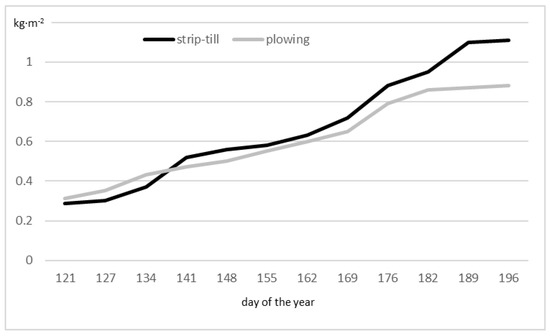
Figure 1.
Dynamics of winter barley dry matter increase depending on cultivation technology (30 April 2016–14 July 2016).
2.5. Data Analysis
A simplified form of the unit [%, v/v] was used to present the soil water content θυ [%, m3·m−3] data. The data are presented in graphs presenting the dynamics of parameter changes. In order to smooth the data used to generate the graphs, the actual results were replaced with moving averages covering 10 consecutive measurements.
3. Results and Discussion
During the experiment, precipitation was irregular (Figure 2). The entire measurement period covered 79 days, during which 237 mm of precipitation was recorded. Since rainfall was the only source of water supply in the soil, it determined the soil moisture, which clearly increased with rainfall exceeding 6 mm in 24 h—9 such cases were recorded. Data analysis indicates that the same amount of precipitation resulted in a greater increase in soil moisture in PT than in ST. The average difference in this increment between the compared tillage technologies was 41.5 percentage points. This is due to differences in soil structure—primarily a greater number of macropores in which water not bound by capillary forces accumulates. Macropores quickly fill with water, which unfortunately quickly infiltrates deep into the soil profile. In the case of ST, more water is held by capillary forces and stays in the soil longer. It then decreases until the next rainfall occurs. This decline was faster in PT than ST (Figure 2 and Figure 3). From 30 April (120th day of the year) until 30 May (150th day of the year)—151–153th day of the year there were of rainfall with a total of 39 mm—soil moisture in ST was higher than in plowing in the range from 1.0 to 4.2%, v/v (average for this period 3.6%, v/v). After the occurrence of the rainfall in question, soil moisture in both cultivation systems almost equalized, reaching a value of 19.6 for ST and 20.2%, v/v for PT. Until the next significant rainfall (38.4 mm), i.e., 17 June (168th day of the year), soil moisture in PT was still lower than in ST and decreased faster than in ST. This indicates a greater water storage capacity in the soil in ST than in PT. Only after the precipitation on 17 June, until the end of vegetation, was the soil moisture in PT generally higher than in ST, and the average difference of the compared objects in this period was 0.97%, v/v. It should be noted that the tendency of soil moisture being in favor of PT occurred when the ST barley was at BBCH 77 and was still transpiring heavily, and the PT barley was at BBCH 87, and transpiration was already lower. As can also be seen from Figure 1, in this period, the barley biomass in ST was higher than in PT. Taking into account that during intensive growth, higher soil moisture is preferable, while lower soil moisture is preferable during ripening; therefore, ST was better in these aspects.
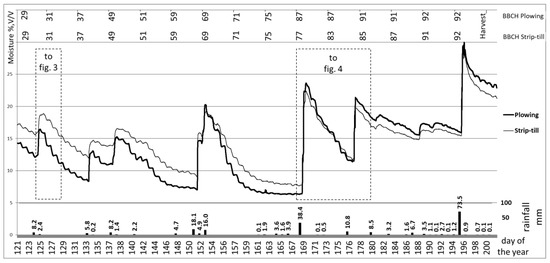
Figure 2.
Soil moisture dynamics depending on cultivation technology (ST vs. PT) against the background of precipitation and development stages of winter barley. Data averaged from row and inter-row.
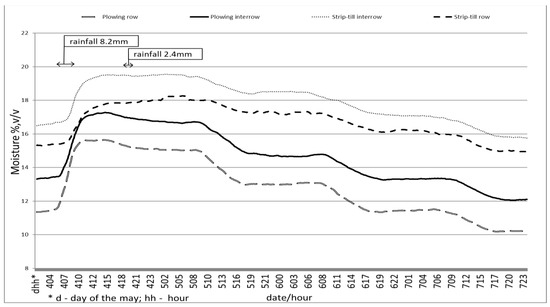
Figure 3.
Dynamics of soil moisture in the row of barley plants and in the inter-row for ST and PT in the period 4–7 May.
Figure 2 shows the dynamics of changes in moisture for averaged values in a row and inter-rows for each of the tillage systems separately for the entire period covered by the research. However, it is reasonable to look at the dynamics of soil moisture with a distinction between rows and inter-rows, as well as to trace these dynamics on a daily basis because it better illustrates the differences in moisture between day and night (Figure 3 and Figure 4). On 4 May, between 4 and 7, there was rainfall, which resulted in an increase in soil moisture in all compared locations (Figure 3). On the same day, another 2.4 mm of rain fell between 18 and 19. In the case of ST, for about a day (from 4 May at 7 o’clock to 5 May at 8 o’clock) after the precipitation, the soil moisture remained at a constant level or even had an increasing tendency (ST row). It should be clarified that in the case of the ST Mzuri technology, the row of plants is located (in furrows) a few cm below the inter-row. This results in the fact that for several hours after rainfall, water not bound by capillary forces drains from the inter-rows located above into the row of plants in the furrow, which explains the described phenomenon. In the case of PT, practically within two hours of the cessation of the first precipitation (8.2 mm), a decrease in moisture was noted in the row and in the inter-row, which was not reversed by the light rainfall in the evening (2.4 mm). This is due to greater water infiltration into the soil profile in PT. ST, on the other hand, was characterized by greater water retention. It should be noted that soil moisture clearly decreased between 8 o’clock and 19 o’clock, i.e., during the period of the highest insolation, and thus, high barley transpiration. The decrease in moisture content in question had a more pronounced course in PT than in ST. This confirms the previously described lower rate of depletion of water resources in the case of ST. In both PT and ST, a higher moisture content was recorded in the inter-row than in the plant row. However, it should be noted that the row vs. inter-row differences in ST were smaller than in PT. In the case of PT, the soil is uncovered, and its surface is loosened. As a consequence, the soil surface in PT in direct contact with the air is definitely larger than in ST, as has been shown by Bulgakov et al. [26]. The consequence is greater evaporation from the soil in PT than in ST [27]. This explains why soil water is depleted faster with PT than with ST. It is relatively recently that ST has started to be used, and it is a compromise between NT and traditional cultivation technology based on plowing. Hence, the first reports on soil moisture depending on the cultivation technology concerned compare NT or simplified tillage to PT. Such studies have shown that moisture conditions were better at all depths of the soil profile with simplified tillage when compared to traditional tillage [28]. However, not everyone agrees with this view as Kovac et al. 2005 conclude that the soil under conventional tillage had significantly higher moisture content than the tested reduced till, mulch till and NT treatments. It should be noted that earlier techniques for measuring soil moisture did not always provide reliable information, especially in dynamic terms. The literature indicates that soil moisture measurement methods, even the newest ones, are burdened with various limitations. The choice of a measurement method is a compromise between the technical possibilities of their implementation and their credibility in given conditions. This means that, depending on the technique of measuring the same objects, different conclusions can be drawn [29,30,31,32,33]. In the research presented in this article, TDR probes were used, which, although they are not selective towards biologically retained water, gave results that are characterized by high reliability in the conditions of the described experiment. The results presented in this manuscript correspond with other experiments demonstrating greater soil water retention with ST than with PT [34,35,36]. However, not all the regularities obtained in our own research are completely consistent with the results of other authors. Jaskulski [35] observed that after heavy rain in a row of plants in ST, the moisture increased faster and decreased faster than in the inter-row. Such reactions were not observed in the studies presented in this manuscript.
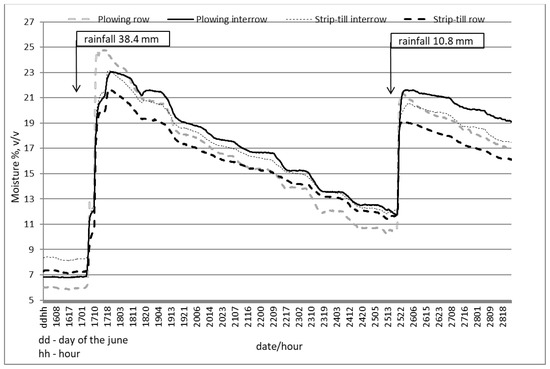
Figure 4.
Dynamics of soil moisture in the row and inter-row ST vs. PT in the period 16–28 June.
As previously described, soil moisture in ST (both in the row and between the rows) was higher than in PT and this held until the moment of heavy rainfall on 17 June. On that day, 38.4 mm fell in three hours. The increase in soil moisture from 6–8.4%, v/v to 21.7–24.6%, v/v lasted about 10 h (Figure 4). At that time, the barley plants in ST were still green (BBCH 77), and the plants in PT (BBCH 87) were already ripe and yellow—hence the intensity of their transpiration was much lower. The air temperature in this period reached 25 °C (Figure 5), which was conducive to a rapid decrease in soil moisture. However, differences in soil moisture between the compared tillage technologies began to decrease. As in the period described above, daily moisture content fluctuations in ST were less than in PT. This situation continued until the next rainfall on June 25. At that time, in PT, the barley grain was already hard, and the plants were dying (BBCH 91), while in ST, they still had a soft waxy maturity (BBCH 85). The water retained after the described rainfall (25 June) was no longer depleted by plants in PT as quickly as by plants in ST; hence, the change in the trend that had been going up until this point, and the soil moisture in PT was now higher than in ST. This new trend was visible both in the row of plants and in the inter-row, although in the ST inter-row, the values were similar to the moisture in the PT row.
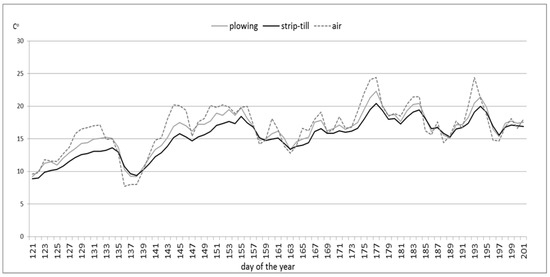
Figure 5.
Dynamics of soil and air temperature (daily averages) depending on cultivation technology (ST vs. PT—average for row and inter-row) throughout the research period.
Changes in air temperature were characterized by greater dynamics than changes in soil temperature, regardless of the technology of its tillage (Figure 5). The soil temperature was generally lower than the air temperature, except for periods of rapid drops in air temperature—inertia of the soil. Averaged for the row and inter-row, the average daily soil temperature in ST was lower than the soil temperature in PT almost throughout the whole vegetation period—on average by 0.64 °C. Extreme average daily temperature differences even reached 1.6 °C (Figure 5). In ST, the temperature was characterized by lower dynamics of changes than in PT (Figure 5 and Figure 6). Soil temperature amplitude (at the measurement interval of 5 min) in PT was definitely greater than ST in the entire vegetation period (Figure 6). Temporary temperature differences in ST vs. PT reached even more than 5 °C. This indicates that the soil in ST better protected the underground parts of plants against thermal stress than was the case in PT. This also explains the lower dynamics of changes in soil moisture in ST than in PT. These results are in line with the opinion of Licht et al. [2] who claim that soils with lower moisture levels (PT) cool and heat up faster than those with higher moisture levels (ST)—which is due to the difference in heat capacity and thermal conductivity of soil and water particles. Soil particles have a lower heat capacity and higher thermal conductivity than water. The obtained results in this present study, which prove that the soil temperature is lower in ST than in PT, are confirmed by Ramakrishna et al. [37] who compared PT vs. NT and showed a difference of 1.97 °C and even 3 °C when the soil surface was covered with plant residues. The slightly greater differences reported by the cited authors may be due to the fact that in the study of this manuscript, the area of ST cultivated strips constituted 1/3 of the total area and was devoid of plant residues.
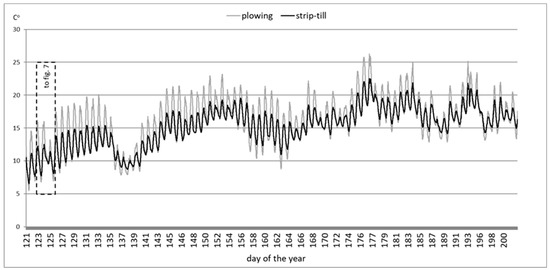
Figure 6.
Dynamics of soil temperature (measuring interval 5 min) depending on tillage technology (ST vs. PT—average for row and inter-row) throughout the research period.
Soil temperatures in the row and inter-row were similar for both compared tillage technologies (Figure 7). However, the temperature in the row was slightly higher than in the inter-row in PT and vice versa in ST. Not only was the amplitude of temperature changes lower in ST than in PT, but also the response time to temperature changes was longer in ST (Figure 5 and Figure 7).
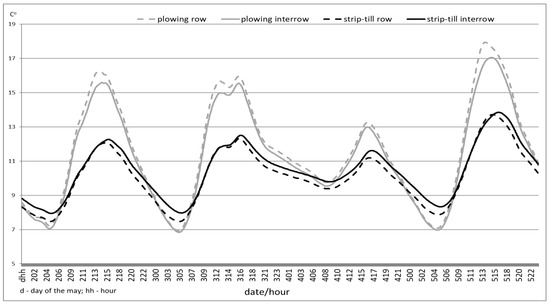
Figure 7.
Soil temperature dynamics depending on the tillage technology (ST vs. PT) in the row and between the rows in the period 2–5 May.
The soil in PT is more porous and enables the water contained in it to evaporate more intensively than is the case when the field surface is covered with post-harvest residues in ST, which is shown in the research of Dahiya et al. [38]; evaporation increases the deeper the soil is loosened [39], which is closely related to the dynamics of soil temperature changes depending on the depth [40]. The consequence of this is a change in the thermal properties of the soil [41]. Soil temperature and its moisture are in a close, dynamic relationship.
4. Conclusions
Based on the analyzed case, it was found that the method of soil tillage affects soil properties, including moisture and temperature and their dynamic changes during plant growth.
It was found that from the beginning of winter barley spring vegetation to mid-June, soil moisture was measured in the layer of intensive growth of plant roots—at a depth of 5–15 cm—in ST and was higher by 3.6% v/v on average than in PT. The amplitude of changes in soil moisture caused by a sudden rainfall and then its absence was greater in the soil cultivated in PT than in ST. In ST, the rate of soil moisture decrease in the rainfall-free period was slower than in deeply and intensively cultivated soil—PT. ST increased water retention in the topsoil; therefore, it can improve productivity in field crop production. Furthermore, the temperature of the soil in ST was less variable both in the daily and long-term cycle compared to PT. Lower soil temperature in ST—the average difference in the study period was 0.64 °C—probably limits evaporation, i.e., unproductive water losses. In conditions of irregular rainfall and especially in long periods without precipitation, ST technology provides plants with access to more water than PT. The underground parts of plants in ST are also subject to lower temperature fluctuations than they are in PT. ST therefore mitigates weather extremes more than PT.
Soil tillage can not only be an element of agricultural technology shaping soil properties in accordance with the requirements of a given crop, but also a way to regulate the effects of meteorological factors, especially their sudden changes in the habitat. It is advisable to extend the research to other soil types and other crops.
Author Contributions
Conceptualization, L.G.; methodology, L.G., I.J., K.K. and Ł.L.; investigation, L.G.; writing—original draft, L.G.; writing—review and editing, I.J., K.K. and Ł.L. All authors have read and agreed to the published version of the manuscript.
Funding
This research received no external funding.
Institutional Review Board Statement
Not applicable.
Informed Consent Statement
Not applicable.
Data Availability Statement
The datasets generated during and/or analyzed during the current study are available from the corresponding author on reasonable request.
Conflicts of Interest
The authors declare no conflict of interest.
References
- Soane, B.D.; Ball, B.C.; Arvidsson, J.; Basch, G.; Moreno, F.; Roger-Estrade, J. No-till in northern, western and south-western Europe: A review of problems and opportunities for crop production and the environment. Soil Tillage Res. 2012, 118, 66–87. [Google Scholar] [CrossRef]
- Licht, M.A.; Al-Kaisi, M. Strip-tillage effect on seedbed soil temperature and other soil physical properties. Soil Tillage Res. 2005, 80, 233–249. [Google Scholar] [CrossRef]
- Schwabe, S.; Gruber, S.; Weber, E.A.; Claupein, W. Vorzüglichkeit des Clearfield—Systems bei Raps unter verschiedenen Bewirtschaftungsintensitäten. Julius–Kühn–Archiv. 2016, 452, 206–209. [Google Scholar] [CrossRef]
- Jackson, J.L.; Beasley, J.P.; Tubbs, R.S.; Lee, R.D.; Grey, T.L. Fall-bedding for reduced digging losses and improved yield in strip-till peanut. Peanut Sci. 2011, 38, 31–40. [Google Scholar] [CrossRef]
- Luna, J.; Staben, M. Using Strip Tillage in Vegetable Production Systems in Western Oregon; EM 8824; Oregon State University Extension Publication: Corvallis, OR, USA, 2003. [Google Scholar]
- Mitchell, J.; Shrestha, A.; Campbell-Mathews, M.; Giocomazzi, D.; Goyal, S.; Bryant, D.; Herrera, I. Strip Till in California’s Central Valley; University of California, Division of Agriculture and Natural Resources, Publication 8361: Los Angeles, CA, USA, 2009. [Google Scholar]
- Morris, N.L.; Miller, P.C.H.; Orson, J.H.; Froud-Williams, R.J. Soil disturbed using a strip tillage implement on a range of soil types and the effects on sugar beet establishment. Soil Use Manag. 2007, 23, 428–436. [Google Scholar] [CrossRef]
- Nowatzki, J.; Endres, G.; DeJong-Hughes, J.; Aakre, D. Strip Till for Field Crop Production: Equipment, Production, Economics; (AE-1370); North Dakota State University Extension Service: Fargo, ND, USA, 2009; pp. 1–8. [Google Scholar]
- Kalinin, A.; Kalinina, V.; Teplinsky, I.; Ruzhev, V. Selection and justification of potato inter row tillage systems based on development of dynamic model of heat and moisture transfer between soil layers. In Proceedings of the Engineering for Rural Development, Jelgava, Latvia, 20–22 May 2020. [Google Scholar] [CrossRef]
- Guan, D.; Zhang, Y.; Mahdi, M.; Kaisi, A.; Wang, Q.; Zhang, M.; Li, Z. Tillage practices effect on root distribution and water use efficiency of winter wheat under rain-fed condition in the North China Plain. Soil Tillage Res. 2015, 146, 286–295. [Google Scholar] [CrossRef]
- Busari, M.A.; Kukal, S.S.; Kaur, A.; Bhatt, R.; Dulazi, A.A. Conservation tillage impacts on soil, crop and the environment. Int. Soil Water Conserv. Res. 2015, 3, 119–129. [Google Scholar] [CrossRef]
- Choudhary, V.K.; Suresh Kumar, P.; Bhagawati, R. Response of tillage and in situ moisture conservation on alteration of soil and morpho-physiological differences in maize under Eastern Himalayan region of India. Soil Tillage Res. 2013, 134, 41–48. [Google Scholar] [CrossRef]
- Fuentes, M.; Govaerts, B.; De León, F.; Hidalgo, C.; Dendooven, L.; Sayre, K.D.; Etchevers, J. Fourteen years of applying zero and conventional tillage, crop rotation and residue management systems and its effect on physical and chemical soil quality. Eur. J. Agron. 2009, 30, 228–237. [Google Scholar] [CrossRef]
- Brunel, N.; Seguel, O.; Acevedo, E. Conservation tillage and water availability for wheat in the dryland of central Chile. J. Soil Sci. Plant Nutr. 2013, 13, 622–637. [Google Scholar] [CrossRef]
- Iqbal, A.; Beaugrand, J.; Garnier, P.; Recous, S. Tissue density determines the water storage characteristics of crop residues. Plant Soil 2013, 367, 285–299. [Google Scholar] [CrossRef]
- Wang, X.; Cai, D.; Hoogmoed, W.; Oenema, O.; Perdok, U. Developments in conservation tillage in rainfed regions of North China. Soil Tillage Res. 2007, 93, 239–250. [Google Scholar] [CrossRef]
- Matula, S. The influence of tillage treatments on water infiltration. Plant Soil Environ. 2003, 49, 298–306. [Google Scholar] [CrossRef]
- Arvidsson, J.; Keller, T.; Gustafsson, K. Specific draught for mouldboard plough, chisel plough and disc harrow at different water contents. Soil Tillage Res. 2004, 79, 221–232. [Google Scholar] [CrossRef]
- Arvidsson, J. Energy use efficiency in different tillage systems for winter wheat on a clay and silt loam in Sweden. Eur. J. Agron. 2010, 33, 250–256. [Google Scholar] [CrossRef]
- Šarauskis, E.; Buragien, E.S.; Romaneckas, K.; Sakalauskas, A.; Jasinskas, A.; Vaiciukevicius, E.; Karayel, D. Working time, fuel consumption and economic analysis of different tillage and sowing systems in lithuania. In Proceedings of the 11th International Scientific Conference “Engineering for Rural Development”, Jelgava, Latvia, 24–25 May 2012; pp. 52–59. [Google Scholar]
- Schillinger, W.F. Tillage method and sowing rate relations for dryland spring wheat, barley, and oat. Crop Sci. 2005, 45, 2636–2643. [Google Scholar] [CrossRef]
- Celik, A.; Altikat, S.; Way, T.R. Strip tillage width effects on sunflower seed emergence and yield. Soil Tillage Res. 2013, 131, 20–27. [Google Scholar] [CrossRef]
- Bulgakov, V.; Pascuzzi, S.; Adamchuk, V.; Gadzalo, J.; Nadykto, V.; Olt, J.; Nowak, J.; Kaminskiy, V. Dynamics of Temperature Variation in Soil under Fallow Tillage at Different Depths. Agriculture 2022, 12, 450. [Google Scholar] [CrossRef]
- WRB. World Reference Base for Soil Resources 2014. International Soil Classification System for Naming Soils and Creating Legends for Soil Maps; IUSS Working Group WRB, World Soil Resources Reports No. 106; FAO: Rome, Italy, 2014. [Google Scholar]
- Skierucha, W.; Wilczek, A.; Szypłowska, A.; Sławiński, C.; Lamorski, K. A TDR-Based soil moisture monitoring system with simultaneous measurement of soil temperature and electrical conductivity. Sensors 2012, 12, 13545–13566. [Google Scholar] [CrossRef]
- Bulgakov, V.; Pascuzzi, S.; Adamchuk, V.; Ivanovs, S.; Pylypaka, S. A theoretical study of the limit path of the movement of a layer of soil along the plough mouldboard. Soil Tillage Res. 2019, 195, 104406. [Google Scholar] [CrossRef]
- Lehnert, M. The Soil Temperature Regime in the Urban and Suburban Landscapes of Olomouc, Czech Republic. Morav. Geogr. Rep. 2013, 21, 27–36. [Google Scholar] [CrossRef]
- Sławiński, C.; Cymerman, J.; Witkowska-Walczak, B.; Lamorski, K. Impact of diverse tillage on soil moisture dynamics. Int. Agrophys. 2012, 26, 301–309. [Google Scholar] [CrossRef]
- Gałęzewski, L. Soil Moisture—Methodical Aspect of Agricultural Research. Habilitation, Bydgoszcz University of Science and Technology, Habilitation Monography, Bydgoszcz, Poland, 2020. [Google Scholar] [CrossRef]
- Rasheed, M.W.; Tang, J.; Sarwar, A.; Shah, S.; Saddique, N.; Khan, M.U.; Imran Khan, M.; Nawaz, S.; Shamshiri, R.R.; Aziz, M.; et al. Soil Moisture Measuring Techniques and Factors Affecting the Moisture Dynamics: A Comprehensive Review. Sustainability 2022, 14, 11538. [Google Scholar] [CrossRef]
- Vereecken, H.; Huisman, J.A.; Pachepsky, Y.; Montzka, C.; van der Kruk, J.; Bogena, H.; Weihermüller, L.; Herbst, M.; Martinez, G.; Vanderborght, J. On the spatio-temporal dynamics of soil moisture at the field scale. J. Hydrol. 2014, 516, 76–96. [Google Scholar] [CrossRef]
- Bittelli, M. Measuring soil water potential for water management in agriculture: A Review. Sustainability 2010, 2, 1226–1251. [Google Scholar] [CrossRef]
- Robinson, D.A.; Campbell, C.S.; Hopmans, J.W.; Hornbuckle, B.K.; Jones, S.B. Soil moisture measurement for ecological and hydrological watershed-scale observatories: A review. Vadose Zone J. 2008, 7, 358–389. [Google Scholar] [CrossRef]
- Jaskulska, I.; Jaksulski, D. Strip-Till One-Pass Technology in Central and Eastern Europe: A MZURI Pro-Til Hybrid Machine Case Study. Agronomy 2020, 10, 925. [Google Scholar] [CrossRef]
- Jaskulski, D. Spatial differentiation of soil moisture in strip-till one-pass technology. Acta Sci. Pol. Agric. 2019, 18, 109–118. [Google Scholar] [CrossRef]
- Jaskulska, I.; Romaneckas, K.; Jaskulski, D.; Wojewódzki, P. A Strip-Till One-Pass System as a Component of Conservation Agriculture. Agronomy 2020, 10, 2015. [Google Scholar] [CrossRef]
- Ramakrishna, A.; Tam, H.M.; Wani, S.P.; Long, T.D. Effect of mulch on soil temperature, moisture, weed infestation and yield of groundnut in northern Vietnam. Field Crop. Res. 2006, 95, 115–125. [Google Scholar] [CrossRef]
- Dahiya, R.; Ingwersen, J.; Streck, T. The effect of mulching and tillage on the water and temperature regimes of a loess soil: Experimental findings and modeling. Soil Tillage Res. 2007, 96, 52–63. [Google Scholar] [CrossRef]
- Adamchuk, V.; Bulgakov, V.; Nadykto, V.; Ivanovs, S. Investigation of tillage depth of black fallow impact upon moisture evaporation intensity. Eng. Rural Dev. 2020, 19, 377–383. [Google Scholar] [CrossRef]
- Sándor, R.; Fodor, N. Simulation of soil temperature dynamics with models using different concepts. Sci. World J. 2012, 2012, 590287. [Google Scholar] [CrossRef]
- Onwuka, B.M. Effects of soil temperature on some soil properties and plant growth. Adv. Plants Agric. Res. 2018, 8, 34–37. [Google Scholar] [CrossRef]
Disclaimer/Publisher’s Note: The statements, opinions and data contained in all publications are solely those of the individual author(s) and contributor(s) and not of MDPI and/or the editor(s). MDPI and/or the editor(s) disclaim responsibility for any injury to people or property resulting from any ideas, methods, instructions or products referred to in the content. |
© 2022 by the authors. Licensee MDPI, Basel, Switzerland. This article is an open access article distributed under the terms and conditions of the Creative Commons Attribution (CC BY) license (https://creativecommons.org/licenses/by/4.0/).